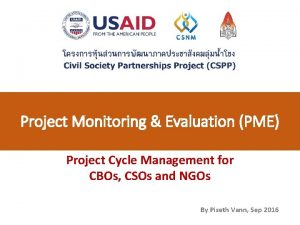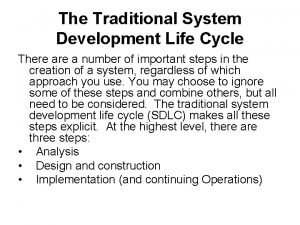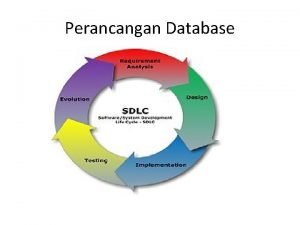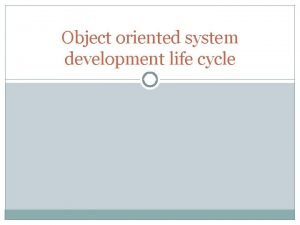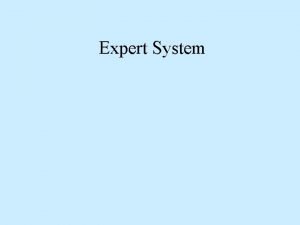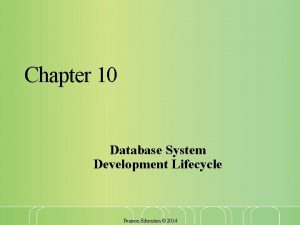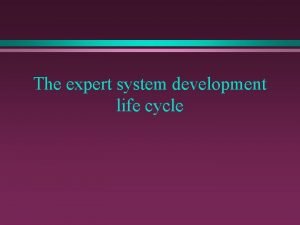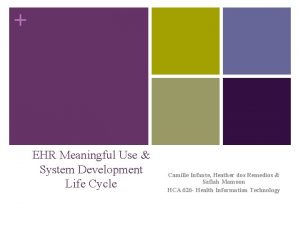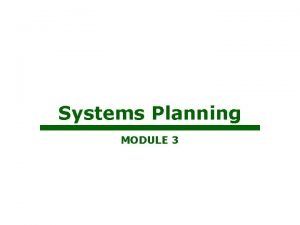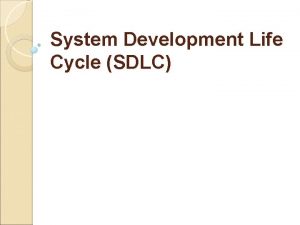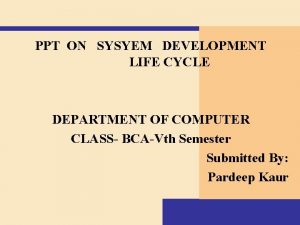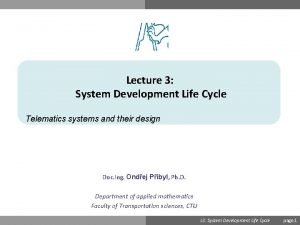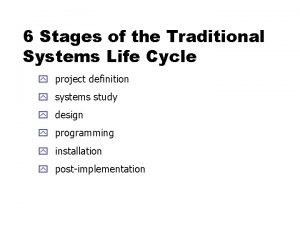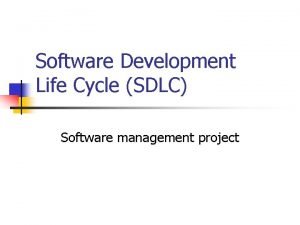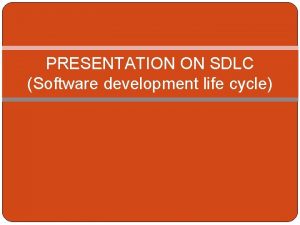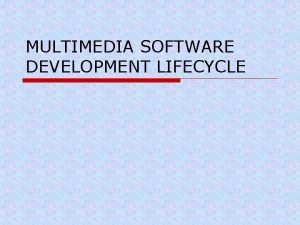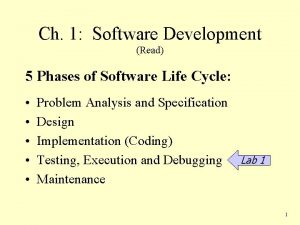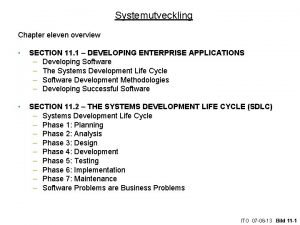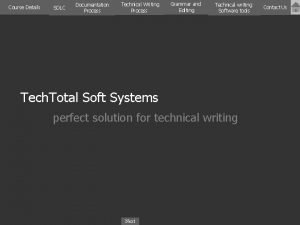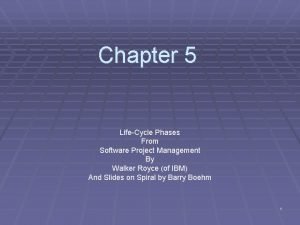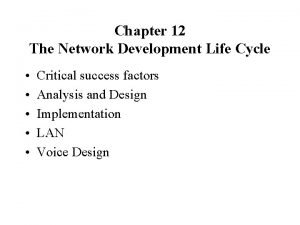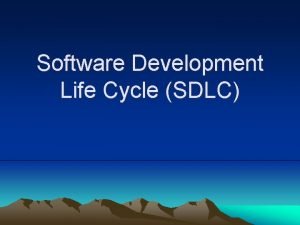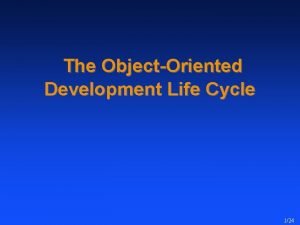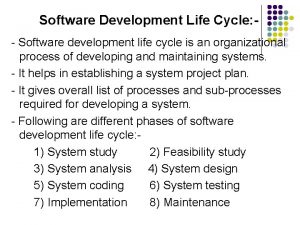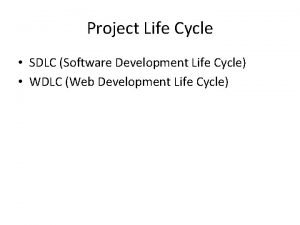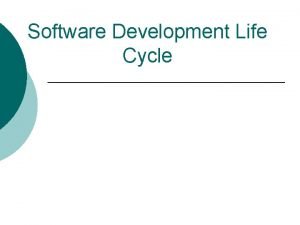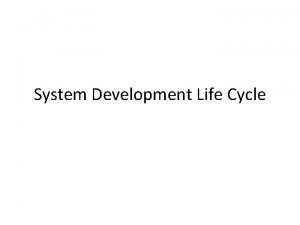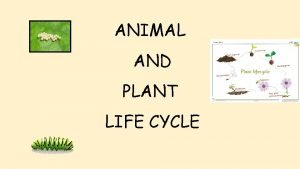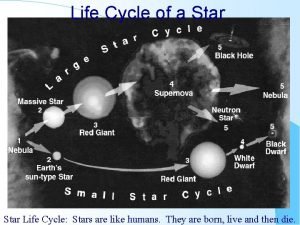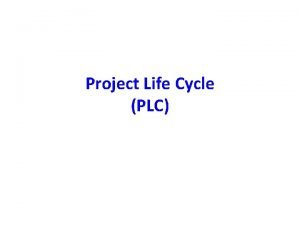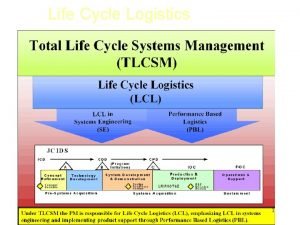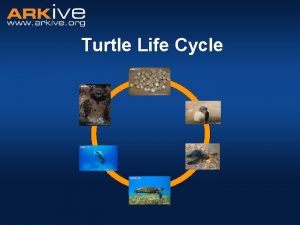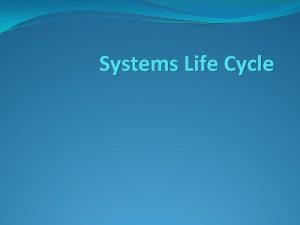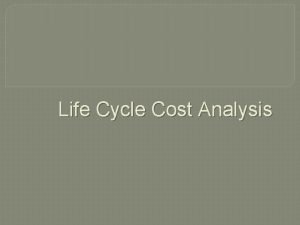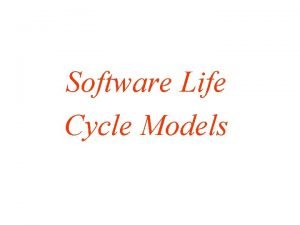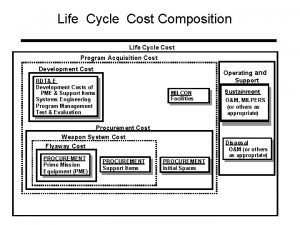The System Development Life Cycle System Evaluation and




























- Slides: 28

The System Development Life Cycle System Evaluation and Selection

Objectives � Discuss the role that technical, economic, legal, operational and schedule (TELOS) feasibility factors play in determining system value. � Discuss the role that productivity, differentiation, and management (PDM) strategic factors play in determining system value. � Describe the maintainability, usability, reuseability, reliability, and extendability (MURRE) design factors and show they help to determine system value.

Objectives � Define cost/benefit analysis and describe its use in financially evaluating general system design alternatives. � Prepare the System Evaluation and Selection Report

System Planning Systems Maintenance Analysis SDLC Conceptual Systems Design System Implement ation Detailed System Design System Evaluation And Selection System Evaluation and Selection

TELOS Feasiblity Factors Worksheet Determine the TELOS Feasibility Score � Rating Technical Feasibility � Rating Economic Feasibility � Rating Legal Feasibility � Rating Operational Feasibility � Rating Schedule Feasibility

TELOS Feasiblity Factors Worksheet Determine the TELOS Feasibility Score � Rating Technical Feasibility ◦ ◦ ◦ Uses established well-known technology ? New technology platform required? New technology is first release by vendor? Multiple vendors involved? Complex networked system?

TELOS Feasiblity Factors Worksheet Determine the TELOS Feasibility Score � Rating Economic Feasibility ◦ Total commitment from top management? ◦ Total development funds allocated and committed? � Rating Legal Feasibility ◦ Corporate counsel satisfied with the system as related to regulations, privacy, industry compliance? ◦ Controls in place?

TELOS Feasiblity Factors Worksheet Determine the TELOS Feasibility Score � Rating Operational Feasibility ◦ Narrow scope with few interfaces? ◦ New global-based system with many interfaces and users? ◦ Automates a know process? ◦ Automates a unique, unknown process? ◦ Involves knowledgeable and commit workers

TELOS Feasiblity Factors Worksheet Determine the TELOS Feasibility Score � Rating Schedule Feasibility ◦ Total development time measure in Hours? Days? Weeks? Months? Years? ◦ System project team uses advanced techniques? ◦ Systems project team has high level of expertise and motivation?

Determine the PDF Strategic Factors Rating � Productivity � Differentiation � Management

Determine the PDF Strategic Factors Rating � Productivity ◦ ◦ Coordinated tasks? Easy and quick access to data/database? Automated transaction processing? Automated low-level tasks?

Determine the PDF Strategic Factors Rating � Differentiation ◦ Style, price, quality, or uniqueness of product or service affected? ◦ Inventory control improved? ◦ Order processing and tracing customer orders improved? ◦ Company's image enhanced?

Determine the PDF Strategic Factors Rating � Management ◦ Provides high-quality information in both form and substance? ◦ Supports budgeting and planning functions? ◦ Gives timely feedback about operations for corrective action? ◦ Gives status information? ◦ Gives early warning signs? ◦ Discloses conflicts? ◦ Assists decision-making tasks

MURRE Design Factors � Maintainability � Usability � Reusability � Reliability � Extendability

MURRE Design Factors � Maintainability ◦ ◦ ◦ Standard data dictionary? Standard programming languages? Standard computer configuration? High degree of modularity? Comprehensive, clear, and current documentation?

MURRE Design Factors � Usability ◦ High level of information and substance? ◦ Form of output fits the cognitive style of the user?

MURRE Design Factors � Reusability ◦ Well-designed, independent modules? ◦ Modules applicable to future applications? ◦ High proportion of software modules reusable?

MURRE Design Factors � Reliability ◦ ◦ ◦ ◦ Mean-time-between failures increases? (MTBF) Mean-time-between repairs decreases? (MTBR) Thorough review and walkthroughs? Effective controls? Fault-tolerant hardware? Rigorous testing procedures to be used? Disaster recovery plan to be established?

MURRE Design Factors � Extendability ◦ Is the system design flexible? ◦ Does the system design indicate an ability to grow and adapt?


Evaluating and weighing the costs and benefits of systems designs What are the costs? � Computing resource costs � Systems development and implementation costs ◦ ◦ ◦ Systems development Equipment installation costs Programming costs Training costs Testing costs Conversion costs

Evaluating and weighing the costs and benefits of systems designs What are the costs? � Operations and Management costs ◦ ◦ ◦ ◦ Staff costs (long list) Supplies (long list) Hardware maintenance Software maintenance Power and light costs Insurance costs Telecommunication costs Building and building services costs

Evaluating and weighing the costs and benefits of systems designs What are the Benefits? � Tangible ◦ Measurable changes in cost – maybe from current system to new system � Intangible ◦ Improved customer satisfaction ◦ Reduce customer check-out times ◦ Shorter lines

Evaluating and weighing the costs and benefits of systems designs Measuring Costs and Benefits? � Accounting details, return on investment, Net Present Value (NPV), Present Value Index (PVI) � how much money is required now, how much later – trade-offs

Selection Detailed line-item reports should be provided for each system alternative being evaluated, including TELOS, MURRE, PDF, Benefit-Cost analysis A side-by side summary for each alternative using the summary scores for comparison should be in the System Evaluation and Selection Report


The Waterfall Model

Key Terms to know, or be familiar with now Terms for Next Year Bottom-up design Global-based Systems Object RAD Encapsulation Classes Group-based systems Object-class library Specialists with Advanced Tool teams Inheritance Data Dictionary Local-based systems Objectoriented design Structuredoriented design Polymorphism Data-oriented approach Messages Objectoriented programming Top-down design Subclass Executive Information System (EIS) Modularity Processoriented approach Superclass
 Pme management definition
Pme management definition Traditional system development
Traditional system development Database development adalah
Database development adalah Oosd life cycle
Oosd life cycle Feasibility study in system development life cycle
Feasibility study in system development life cycle Life cycle of expert system
Life cycle of expert system Embedded design life cycle
Embedded design life cycle Database development life cycle with example
Database development life cycle with example Life cycle of expert system
Life cycle of expert system System development life cycle of electronic health records
System development life cycle of electronic health records System development life cycle
System development life cycle System development life cycle
System development life cycle Sysyem software
Sysyem software Cross life-cycle activity of system development is
Cross life-cycle activity of system development is Kendall system analysis and design
Kendall system analysis and design Traditional system development life cycle
Traditional system development life cycle New product development and product life cycle strategies
New product development and product life cycle strategies Software
Software Software development life cycle ppt
Software development life cycle ppt History of software development life cycle
History of software development life cycle Multimedia development life cycle
Multimedia development life cycle Odw 5e ch05 arrange the software development life cycle
Odw 5e ch05 arrange the software development life cycle Document development life cycle
Document development life cycle Document development life cycle technical writing
Document development life cycle technical writing Life cycle phases in software project management
Life cycle phases in software project management Network development life cycle
Network development life cycle Capability maturity model sdlc
Capability maturity model sdlc Object oriented development life cycle
Object oriented development life cycle Siklus hidup produk sunlight
Siklus hidup produk sunlight
